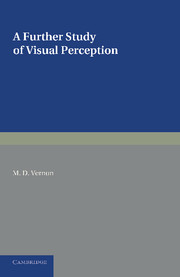Book contents
- Frontmatter
- Contents
- List of Illustrations
- Acknowledgements
- Chapter I INTRODUCTION
- Chapter II THE NATURE OF PERCEPTION
- Chapter III THE PERCEPTUAL PROCESS
- Chapter IV THE DETERMINATION OF FORM
- Chapter V SPATIAL PERCEPTION
- Chapter VI THE CONSTANCIES
- Chapter VII THE FUNCTIONS OF THE FRAMEWORK IN PSYCHO-PHYSICAL EXPERIMENTS
- Chapter VIII THE PERCEPTION OF MOVEMENT
- Chapter IX MICHOTTE'S STUDIES OF SOME INTRINSIC PHENOMENA OF EXPERIENCE
- Chapter X THE INFLUENCE OF INTERNAL AND INDIVIDUAL FACTORS UPON PERCEPTION
- Chapter XI CONCLUSION
- Appendix A
- Appendix B
- References
- Index of Authors
- Index of Subjects
- Frontmatter
- Contents
- List of Illustrations
- Acknowledgements
- Chapter I INTRODUCTION
- Chapter II THE NATURE OF PERCEPTION
- Chapter III THE PERCEPTUAL PROCESS
- Chapter IV THE DETERMINATION OF FORM
- Chapter V SPATIAL PERCEPTION
- Chapter VI THE CONSTANCIES
- Chapter VII THE FUNCTIONS OF THE FRAMEWORK IN PSYCHO-PHYSICAL EXPERIMENTS
- Chapter VIII THE PERCEPTION OF MOVEMENT
- Chapter IX MICHOTTE'S STUDIES OF SOME INTRINSIC PHENOMENA OF EXPERIENCE
- Chapter X THE INFLUENCE OF INTERNAL AND INDIVIDUAL FACTORS UPON PERCEPTION
- Chapter XI CONCLUSION
- Appendix A
- Appendix B
- References
- Index of Authors
- Index of Subjects
Summary
Since this book went to press, there has appeared a new publication by Gibson (1950), much of which is extremely opposite to the arguments presented above. It seemed therefore to be most desirable to include in this book some discussion of Gibson's work. Gibson's main thesis is advanced as a contradiction, or at least a correction, of the theory that our perceptions are individual schematized constructions based only in part upon data given by the retinal impressions. He considers that in fact the perceptions of different observers are far more alike than such a theory would lead one to suppose, and also they reflect more accurately the nature of the external world. Thus he emphasizes the likeness, the consistency, and the accuracy of our percepts, rather than their imperfections, their inconsistencies, and their individual differences, which he conceives to originate largely in the artificially simplified conditions of laboratory experiments on perception.
Gibson postulates that the retinal impression, though not a photographic ‘picture’ of the external world, nevertheless is closely correlated to the variations in light stimuli arising from the external world. The retinal impression in turn is closely correlated to the momentary percept of a single stationary eye. This Gibson calls the ‘visual field’, which is an extent, bounded by the limits of clear vision, filled with flat patches of different shapes, colours, and sizes, clearly discriminable from one another. It shows abrupt transitions which we see as edges or contours, and a regular patterning which we see as surface texture. But we become aware of the ‘visual field’ only by introspective analysis from our total long-term experience, which Gibson calls the ‘visual world’. This consists of solid stable objects localized in an unbounded or panoramic space. It is built up through the integration of innumerable overlapping adjacent and successive momentary percepts, obtained in successive ocular fixations. These percepts resemble one another in certain respects while differing in others. Since there is continual movement of the eyes and head in viewing the external world, there is continual transposition of stimulation on the retina.
- Type
- Chapter
- Information
- A Further Study of Visual Perception , pp. 260 - 261Publisher: Cambridge University PressPrint publication year: 2013



